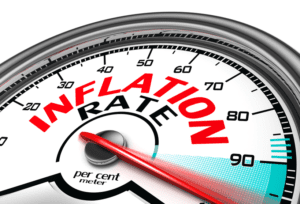Inflation in Kenya has hit a twenty seven (27) month high. This occurred in the just concluded month of May 2022 due to increases in the prices of essential items like Soaps, Cooking Oil, Fuel, and foodstuff, resulting in severe strains on the spending power of households as well as on their demand for services and goods.

The Kenya National Bureau of Statistics (KNBS) made it known on Tuesday the 31st of May 2022 that the cost of living in Kenya increased to 7.1 percent in May of 2022 from the 6.5 percent which was the case the month before.
This is the highest inflation rate that Kenya has faced since February of 2020 when it hit 7.2 percent and resulted in the Central Bank of Kenya (CBK) issuing a warning stating the measure was at the risk of going higher than the Kenyan government’s target of 2.5 to 7.5 percent.
The 27 month high has led to a significant number of households in Kenya especially those in the low income bracket reducing their shopping at a time where businesses have struggled to pay salaries of their staff as they continue to recover from the damage inflicted by the still ongoing Coronavirus pandemic.
Read Also: Interest Rate Increased By CBK To Combat Inflation
With more and more individuals in Kenya continuing to slash their spending on non essential commodities like airtime and alcohol companies like Airtel Kenya, Safaricom, Telkom, and East Africa Breweries Limited (EABL), will definitely feel the impact in their revenue.
The Managing Director of the Kenya National Bureau of Statistics (KNBS); Macdonald Obudho made it known via a statement that, “The rise in inflation was mainly due to increase in prices of commodities under food and non-alcoholic beverages (12.4 per cent); furnishings, household equipment and routine household maintenance (7.9 per cent); transport (6.4 per cent) and housing, water, electricity, gas and other fuels (6.0 per cent) between May 2021 and May 2022.”

On Tuesday the 31st of May 2022 the Central Bank of Kenya (CBK) warned the nation with regards to the “clear and present danger” of the current inflation going above the upper limit of 7.5 percent in the months to come. If this happens, it will be the first time since August of 2017 when it hit 8.04 percent.
The inflation rates in most countries around the world have risen to multi year highs due to rebounds in their economic activities, which put additional pressures on the supply chains which have already experienced numerous interferences, and led to food and energy getting even more expensive.
The supply chain interferences coupled with how they have impacted inflation rates are significantly out of the control of the central banks. Even with this however, majority of the central banks which have been affected, have started adjusting their monetary policies in a bid to control the rising inflation.
Read Also: Governor Of CBK Responds To Parallel Exchange Rate Fears
The Central Bank of Kenya (CBK)’s Monetary Policy Committee (MPC) which is targeted at Inflation increased the benchmark Central Bank Rate (CBR) on Monday the 30th of May 2022 from the 7 percent it had stayed at since April of 2020 to 7.5 percent. The Central Bank Rate (CBR) is referred to as the signal for direction with regards to interest rates.
The Governor of the Central Bank of Kenya (CBK); Patrick Njoroge stated on Tuesday the 31st of May 2022 stated that, “We will take all measures necessary to deal with inflation. But it is clear that on supply side-driven inflation [growth in cost of commodities], there’s virtually nothing that monetary policy can do. What monetary policy does is to deal with second-round effects.”

The Central Bank of Kenya (CBK) Governor added that, “Even then, we understand that this [rise in CBR] is not totally effective. That will need some time, say about three months, to be completely embedded in the economy.”
With the increasing costs of commodities employees have been hit the hardest especially considering that the average wages when adjusted for inflation, were at negative 3.83 percent in 2021 compared to the 0.59 percent that was the case in 2020.
Read Also: Public Debt in Kenya Now At 8.4 Trillion Kenyan Shillings
Employers believe that the wages will take some time to get better as the economy continues to recover from the effects of the still ongoing Coronavirus pandemic which had led to numerous pay cuts, layoffs and businesses closing down.
The private sector in Kenya had also been affected by the current inflation. In April of 2022 activity in the sector dropped significantly due to shortages in supply for specific goods at a time when consumer inflation continued to rise.
Read Also: Mobile Money Transactions In Kenya Reach 1.82 Trillion Kenyan Shillings First Quarter of 2022
The S&P Global Kenya Purchasing Managers’ Index (PMI) hit 49.5 from the 50.5 that was the case the month before. The 50.0 mark is what separates contractions from growth in activity.
The survey revealed that as a result of the rise in inflation, demand from customers have slowed down.
Kuria Kamau who is a Fixed Income and Currency Strategist at Stanbic Bank stated that, “Domestic demand fell, driven by reduced client spending following significant increases in food and fuel prices.”
Read Also: Higher Data and Airtime Taxes Result In KRA Losing Billions
Data from the Kenya National Bureau of Statistics (KNBS) revealed that in May of 2022, Fat and cooking oil increased the most by 47.09 percent to an average of 370.71 Kenyan Shillings from the average of 252.03 Kenyan Shillings that was the case in 2021.
The commodity with the second highest increase was Wheat Flour which experienced an increase of 28.45 percent from what was the case in 2021, to 165.89 Kenyan Shillings for two (2) kilograms. For Maize Flour, it experienced an 23.80 percent increase for a two (2) kilogram packet to hit an average of 148.57 Kenyan Shillings.
The data from the Kenya National Bureau of Statistics (KNBS) also revealed that an 800 gram bar of soap now averages at 153.67 Kenyan Shillings. This signifies an increase of 25.92 percent when compared to the 129.15 percent that was the case in 2021.

In addition, households in Kenya paid about 21.49 percent more for a litre of Diesel when compared to the 131.91 Kenyan Shillings that was the case in 2021. Diesel is majorly used in transportation as well as in farming.
For Petrol, it experienced an 18.65 percent increase to arrive at an average of 150.94 Kenyan Shillings per litre.
Read Also: Fuel Prices In Kenya To Reach Highest In Country’s History Without Subsidy
Spinach, Milk and Beef also experienced increases in prices with Spinach rising by 12.35 percent to hit 69.86 Kenyan Shillings per Kilogram, Milk by 16.32 percent to hit 57.30 Kenyan Shillings, and Beef by 9.11 percent year on year to arrive at 513.07 Kenyan Shillings per kilogram.
In the words of the Governor of the Central Bank of Kenya (CBK); Patrick Njoroge, “With rains, we expect that fast-growing crops like Sukuma Wiki, tomatoes and even potatoes will come to the market and therefore exert a downward pressure on food prices and inflation.”
The increase in prices of basic commodities is being attributed to a corresponding increase in the costs worldwide as a result of the continued interruptions in the supply chain.
Read Also: Prices For Land and City Homes Experience Fastest Boost In Years
The United Nations Food and Agriculture Organization’s food index revealed the cost of edible vegetable oils like Sunflower Oil, Crude Palm Oil, Corn Oil, and Soybean Oil which are also used in the manufacturing of Soaps and Cooking Oils, increased by an average of 27.8 percent between January 2022 and May 2022 to add to the 36.1 percent increase from 2021.
The United Nations (UN) revealed that Murban Oil and Wheat, also experienced increases in their global prices by 27.3 percent for Murban Oil and by 52.9 percent for Wheat.
How informative was this article? Are there any other news topics, categories, or How To topics, that you would like us to write on? Feel free to reach out to Nexbit KE in the comment section.


